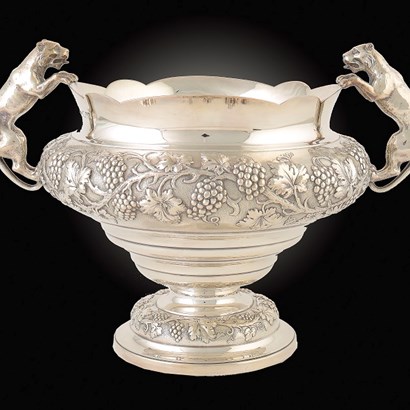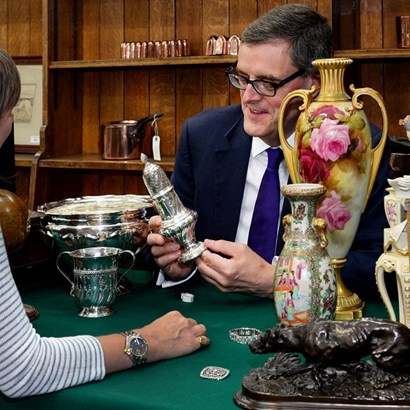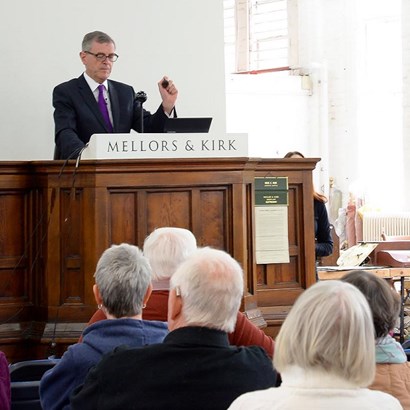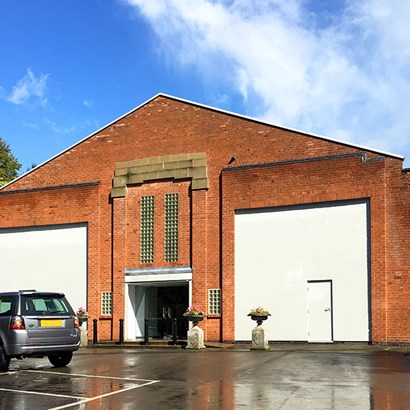Auction Insights
Carreglwyd Country House Sale
Recently I came face to face with a Welsh druid, or ‘derwydd’. Not a real sorcerer, but an equally mesmerising object: a silver snuff box must unusually in the form of a druid’s head, and quite possibly unique. It was just one of what it soon became clear amounted to a wonderful ‘time capsule’ of one family’s hoarding over generations. Although the house, Carreglwyd in Anglesey, is still the much-loved home of the Carpenter family, the time has come when it is simply no longer possible to hang on to everything.
Country House dispersal sales such as this are now very seldom. They are quite different from sales of collections formed in living memory. For that reason, I would urge anyone interested in the past to view them, whether they want to buy or not, because although each one is unique in itself, they are a genuine window into the taste and habits of the Georgians and Victorians.
At Carreglwyd long hours were spent unwrapping, sorting and cataloguing the hundreds of objects once thought worthy of keeping for posterity, including the odd treasure. Transported lock, stock and barrel to Nottingham it will go under the hammer at the Auction House on June 21st. The druid box, estimate £3000-4000, is only one of the Sale’s highlights.
For the romantic at heart there are two rare examples of posy or ‘poesie’ rings. These resemble heavier than usual plain gold wedding rings but have a secret motto or inscription normally invisible and known only to the wearer. They were popular in England in the 16th and 17th centuries and the messages inside these two examples are Your Love +mi Life+ and Fé Fidalgula (faith and nobility). They were found in Lady Reade’s ‘Cabinet of Curiosities’. More about her later, but the cabinet contained a great many other items, all still bearing handwritten labels such as ‘Princess Bronwen’s bead dug up on the Alaw river bank 1811’ and a ‘Celt found at Llandfair PG 1866’. Others included ‘A tooth of the king of Portum… presented to me by Mr Donovan, the tooth dropped out of the skull in his presence’, a piece of wood from one of the sunken ships in Sebastopol harbour and something the good lady described as ‘An Indian idol’.
There is also a 19th century miniature model of Stonehenge beneath a glass dome, some Jacobite memorabilia including what is said to be a lock of Bonnie Prince Charlie’s hair in a heavy gold locket, relics from the field of Waterloo picked up by one of the Carpenters, who fought in the battle. Such impeccable provenance makes all the difference to the price. Best of these items is a piece of woven trimming with the imperial eagle and initial of Napoleon, together with a French tricolour cockade from a French soldier’s hat. I also discovered a silver vesta case still in its scarlet leather box which had been a gift from the Prince of Wales in 1914. As King Edward VIII, he abdicated to marry Wallis Simpson.
Amongst the family portraits of Carpenters, Griffiths and Trygans, china, glass, oriental objects, dolls and games I found an early 19th century painted card optical toy. On pulling a cotton thread in the centre of what appeared to be a small painting of a country cottage it became a 3D model be hive containing a rat hanging by its tail!
An ancestor, Holland Griffith (17156-1839) was a prominent member of the Anglesey Druidical Society, a fraternal club of local landed gentry who met once a month for a convivial evening at a Beaumaris inn. His was the snuff box, as was lot 71, the splendid Irish silver ceremonial trowel with which he was presented for laying the foundation stone of the George IV Arch at Holyhead.
There are Victorian military officer’s uniforms and family medals, including those of Frederick Carpenter for the Crimean War and also his fascinating manuscript 1854 Diary, an entry in which reads “I went on the field this evening after the Battle [of the Alma] and …. the ground in some parts was literally strewed with the dead and wounded, many of the latter would not be removed that night.” Then there are the posthumously bestowed medals of Jack Carpenter, one of only 33 Canadians who flew in the Battle of Britain. An RAF Hurricane pilot on 8th September 1940 he bailed out during a Luftwaffe attack over the Isle of Sheppey but his parachute failed to open.
This is the most recent item in the Sale but the oldest is a necklace of ancient Egyptian glass beads and something alarmingly labelled “Part of an Egyptian mummy’.
A particularly interesting figure is Maria Conway-Griffith (1840-1911) who married in 1880 Sir Chandos Stanhope Hoskyns Reade, 8th Bt. Her life was not without its adventures, which included accompanying her then fiancé, Sir Love Jones-Parry on an 1859 holiday to Spain which resulted not only in a permanent rift in their relationship shortly after their arrival in Gibraltar, but also in being put on trial for his life for assaulting a sentry at La Linea. A leading light in the Women’s Total Abstinence Union and an energetic supporter of temperance in Anglesey, she was also a keen collector, assiduously labelling curiosities that she and other members of this well-travelled family had acquired over the years.
Carreglwyd is now more likely to be known to many as home of the annual Gottwood Festival. I will not speculate on what Lady Reade would have thought of this weekend’s very loud celebration of electronic music (artists including ‘2 Bad Mice’) the thousands of cool young people, numerous bars and village of tents and yurts. Who knows, a hooded and bearded druid or two might even be spotted in the densely wooded surroundings….
< Back to Auction Insights



